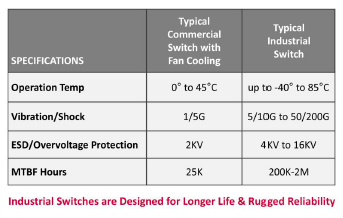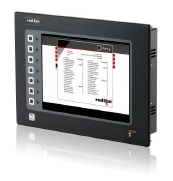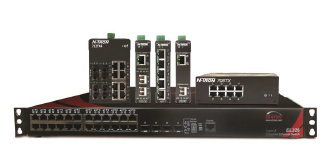Just as ice formation can stop the flow of a river, extreme temperatures can stop the flow of data from remote operations. Because modern facilities and control systems run on information, even a brief interruption to data flow can introduce significant risk to operations. Commercial-grade Ethernet switches have proven to be especially vulnerable because they are not engineered to withstand the fluctuating temperatures, humidity, vibration, dust and other conditions common to remote environments. Instead of routing data, commercial-grade Ethernet switches often experience failures such as shutdowns when faced with extreme conditions. Designed for climate-controlled data centers and wiring closets, these switches should not be used in outdoor locations.
Extreme conditions do not need to make the network go down. Today, thousands of industrial-grade Ethernet switches are performing reliably in remote locations around the world. While industrial Ethernet switches can’t prevent extreme conditions, they can prevent costly consequences. Keeping switches and the systems that depend on them functioning requires an understanding of how extreme conditions affect performance, knowledge of the different types of switches and their limitations, and an understanding of the features required to mitigate changing conditions. This white paper will explore ways to optimize the network for maximum uptime.
How Extreme Conditions Impact Network Operations
As an Ethernet switch approaches the limits of its operating temperature, it starts slowing down and may drop packets. When an Ethernet switch gets too cold or hot, its components simply fail to function. That means that data cannot be communicated or stored, which blocks visibility into operations and hampers automated control systems. The value of the data managed by Ethernet switches in remote environments is not only the data itself, but the crucial role it plays in supporting automated network systems. Interrupted flow of data may cause networking equipment, production control software, and even security and safety systems to shut down unexpectedly. When this happens, operators are left without working systems, and perhaps without the ability to diagnose and correct issues before they become major problems.
Network failures pose a significant threat to safety, productivity and profitability. System crashes can create a dangerous lack of visibility into operations and can shut down safety systems. They also create a financial liability, since emergency repairs cost much more than planned preventive maintenance, especially in remote locations. Failures also carry a high productivity price – one customer estimates that unplanned downtime costs the company $10,000 per minute. The costs could be even higher at offshore rigs, wind farms, pipelines and other work environments where skilled maintenance technicians and spare parts may be miles away.
When Failure is Not an Option
Failures are problematic, but they are also highly preventable. Network failures are extremely rare when the Ethernet switch is properly matched to the operating environment. Making the match requires an understanding of two types of switches – commercial and industrial – and the limitations of each.
Commercial-Grade Ethernet Switches
Commercial-grade Ethernet switches are typically used in climate-controlled environments such as offices and other indoor locations where there is little exposure to temperature extremes, shock, vibration and electrical noise that can impact performance. Commercial switches are typically rated to operate in temperatures ranging from 0° to 45°C (32° to 113°F), which is an important consideration when selecting switches for remote operations. They also usually require on board fans.

Industrial-Grade Ethernet Switches
Industrial-grade Ethernet switches reliably perform in temperatures ranging from -40° to 85°C (-40° to 185°F), which means they work in extreme environments that are difficult for people to access. Industrial switches are an essential part of the automated control systems used in industries such as energy, oil and gas, transportation, manufacturing and more. The accompanying chart presents a side-by-side comparison of the specifications of both commercial and industrial switches. Industrial switches, for example, are capable of operating for 20 to 30 years in the field, while the MTBF (Mean Time Between Failure) for commercial switches is often less than 3 three years.
Prevent Problems with Advance Warning

Many industrial switches offer diagnostic capabilities that help prevent downtime by proactively issuing alerts before falling temperatures and other extreme conditions can cause a problem. One optional feature is for the switch to regularly send packets of diagnostic data that can be integrated into a management system or viewed on a human machine interface (HMI). The person or system responsible for monitoring the switch can view port-by-port data flow to easily see the slowdowns that may indicate an impending problem. More advanced switches offer embedded browser functionality that provides more powerful diagnostic capabilities and enables remote troubleshooting. Data can be viewed and processed in real time, and also shared with databases and other applications for analysis and maintenance planning. These capabilities are native to many industrial switches. Similar functionality is available for commercial switches, but complex configuration and programming is required.

Industrial Switches Get the Job Done
While organizations can’t depend on good weather and perfect environmental conditions, they can rely on high performance and increased uptime when the proper industrial-grade Ethernet switches and other components are selected for the job. The key is to use rugged products that are engineered for the environment and can be managed remotely and proactively to prevent problems, regardless of operating conditions. Industrial Ethernet switches are engineered to get the job done – even when conditions are uncomfortable for workers and unmanageable for commercial-grade products.
Red Lion Controls provides industrial Ethernet switches that combine high performance with rugged reliability to provide a “best of both worlds” solution for many of today’s industrial applications. Our N-Tron® and Sixnet® series of hardened switches are ideally suited for harsh and outdoor environments that include alternative energy, power substations, oil and gas, transportation and other industries where real-time performance under extreme operating conditions is required. Built-in redundancy coupled with advanced security and network management ensures the infrastructure stays up and running while providing tools for monitoring and tracking. Visit www.redlion.net/industrial-networking to learn more about our unmanaged, monitored, managed and Power over Ethernet (PoE) switches.



